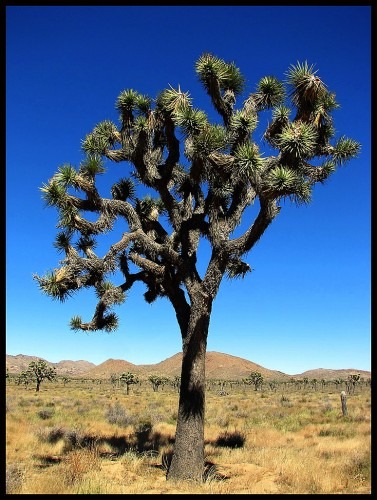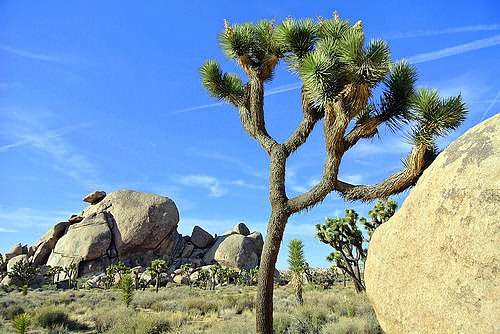Something  about the Joshua Tree always makes me smile. No, I am not talking about one of the greatest rock and roll albums of all-time by Irish rock band U2. I am talking about Yucca brevifolia; a plant species belonging to the genus Yucca. It is a monocotyledonous tree native to southwestern North America in the states of California, Arizona, Utah and Nevada, where it is confined mostly to the high desert region of the Mojave Desert between 400 and 1,800 m (1,300 and 5,900 ft) elevation.
about the Joshua Tree always makes me smile. No, I am not talking about one of the greatest rock and roll albums of all-time by Irish rock band U2. I am talking about Yucca brevifolia; a plant species belonging to the genus Yucca. It is a monocotyledonous tree native to southwestern North America in the states of California, Arizona, Utah and Nevada, where it is confined mostly to the high desert region of the Mojave Desert between 400 and 1,800 m (1,300 and 5,900 ft) elevation.
The Joshua tree name was said to be given by a small group of Mormon settlers who crossed through the Mojave Desert back in the mid-19th century. It is said the unique shape of the Joshua tree reminded them of a Biblical story where Joshua reached his hands up to the sky in prayer.
Joshua trees are fast growers for the desert; new seedlings may grow at an average rate of 7.6 cm (3.0 in) per year in their first ten years, then only grow about 3.8 cm (1.5 in) per year thereafter. The height for a Joshua tree varies from 15 to 40 feet and has a diameter of 1 to 3 feet. The trunk of a Joshua tree is made of thousands of small fibers and lacks annual growth rings, making it difficult to determine the tree’s age but if it survives the rigors of the desert it can live for hundreds of years with some specimens surviving up to a thousand years. (Sadly the one featured on the U2 album cover has since died.) Like the Sequoia Tree, the Joshua Tree seems to have been around almost forever.
Joshua trees are one of the species predicted to have their range reduced and shifted by climate change and according to an article in the Las Vegas Review Journal are in a race against extinction. There is some concern that they will be eliminated from one of my favorite places in the world- Joshua Tree National Park and that this will damage and fundamentally transform the ecosystem of the park.
And here is a weird thing, and I will give you a second to wrap your head around this one- technically, the Joshua tree is a member of the lily family. Go ahead and think about that for a second.
These trees are only pollinated by the Pronuda Moth. The moth is commonly called the Yucca Moth. The moth evolved special organs so that it is possible for the moth to pollinate the Joshua flower. The larvae of the Yucca Moth feed on the seeds of the Yucca. The Joshua tree could not reproduce without the moth’s pollination and likewise the moth is equally dependent on the Joshua tree. That is pretty cool! Yet as average temperatures rise and droughts grow longer and more frequent live is becoming much harder for the Joshua tree and the moth.
If you find yourself in the south west United States and happen upon a deserty area, keep an eye out for the Joshua tree. Notice how beautiful it is and marvel about how long it has stood there. Then notice the smile start to grow on your face. It is hard to help it. Trust me. The Joshua tree always makes me smile.
Have you ever seen a Joshua tree in your travels? Which is your favorite U2 album? Did you ever see a U2 concert? Let me know in the comments. Would love to hear your story.
If you liked this or any other posts you read on 1KSmiles, please share it with your friends using the Shareaholic buttons below.
And feel free to ‘like’ us on our Facebook page.
Start reading Joshua Tree: The Complete Guide: Joshua Tree National Park instantly on Kindle from Amazon. Click here.



